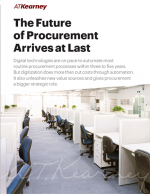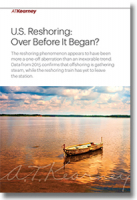Building a Bolder Legacy: The Procurement Mission Is Under Way
The call for procurement to create and manage for value is becoming more intense, and the question is, will the profession more broadly seize the opportunity?
As the narrative on “value” grows louder and spreads wider across many forums, procurement is generally viewed as a function in search of improved performance, consistency, and more predictable results.
The search is beginning to bear fruit according to findings in our 2015 ROSMA study as more procurement leaders are stepping up and embracing the value challenge.
The objective is clear: When 90 percent of the finance community is able to identify what portion of savings are secured by procurement, that’s when procurement has all the right answers to all the key questions.
That’s when procurement delivers value.
The 2015 Return on Supply Management Assets (ROSMASM) Performance Check study, Building a Bolder Legacy: The Procurement Mission Is Under Way, finds that top performing procurement organizations improved their performance versus the 2014 report, with most delivering 10 to 15 times returns.
Top performers were also found to deliver 7.5 times the costs and investment base in procurement and are expanding their advantage. These leaders generate about $1.25 million in financial benefits per procurement employee per year.
The study finds that performance varies widely across all of procurement’s key value drivers, including spend coverage, sourcing program velocity, sourcing project yields and outcomes, compliance rates, and operating costs. Procurement remains a function plagued with inconsistent performance in delivering strategic activities.
Many companies are beginning to embrace zero-based budgeting (ZBB). Companies employing ZBB demonstrate game-changing improvements in shareholder value performance by forcing rigorous alignment of resources and expenses. The transparency of ZBB provides top procurement organizations with the opportunity to bring significant value to financial decisions through knowledge of details, behaviors, and costs.
The study authors also note that procurement organizations have the opportunity to attract millennials if the profession is willing to make changes regarding performance tracking and accountability. Millennials prefer to join organizations with value-management practices, specifically where there is transparency, accountability, and recognition of their achievements. Procurement offers millennials the opportunity to learn the business from end-to-end, secure executive access and exposure, and have a significant impact on business performance.
The report also includes validating insight commentary from one of the largest private equity firms reflecting on the procurement performance of their portfolio companies, CPOs of two Fortune 100 companies, the Americas CFO of a Fortune 500 company, and the CEOs of ISM and CIPS.
What’s Related




Favorites





